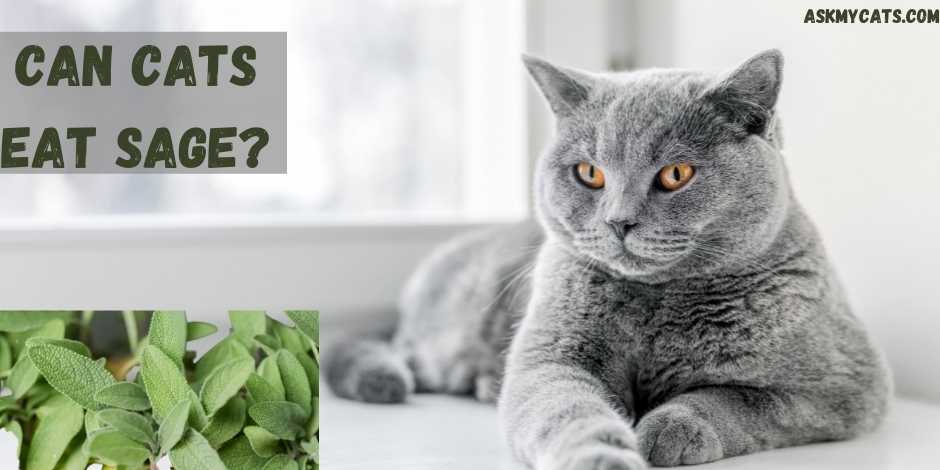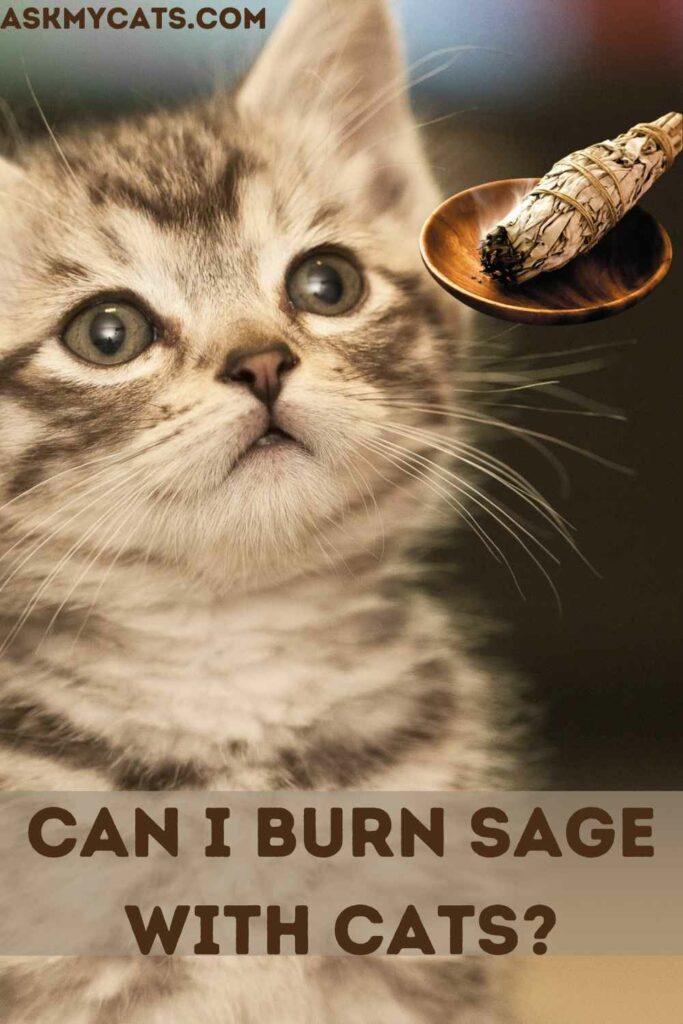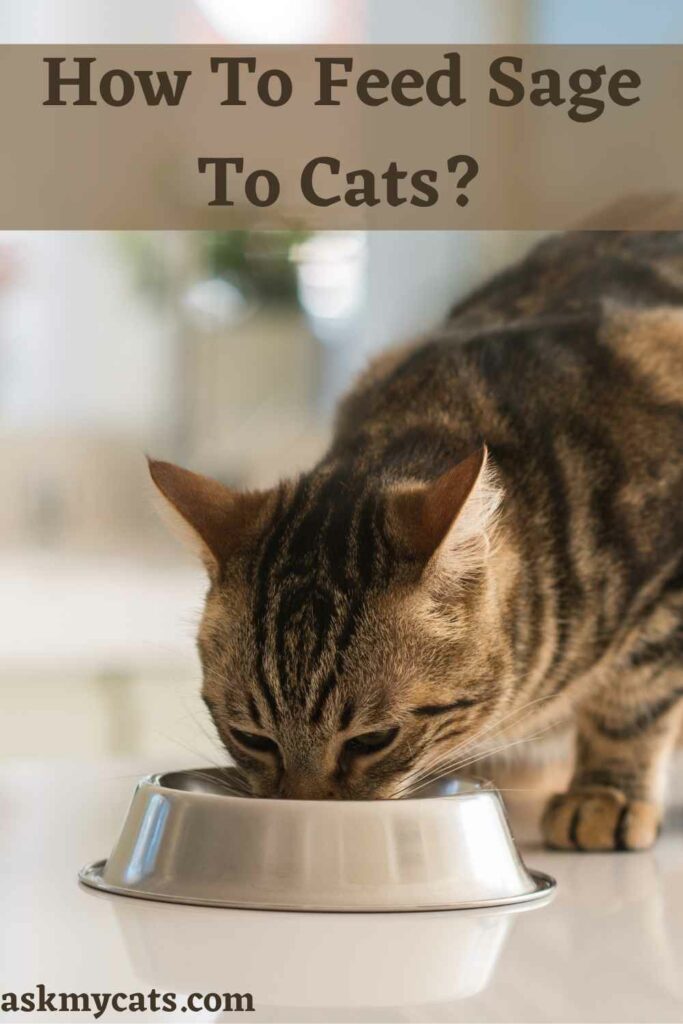Sage is a common plant that may be found in and around the house, and it has a soothing and refreshing scent. Sage, or Salvia officinalis, is a perennial evergreen subshrub with woody stems, greyish leaves, and blue to purplish flowers that are used in cooking, medicine, and as a decorative plant. So, can cats eat sage?
Yes, cats can eat sage. Sage is non-toxic to cats, according to numerous research. You don’t have to be concerned if your cat eats a small amount of this scented herb’s leaves. Because cats’ digestive systems are designed for meat, ingesting a lot of sage causes serious stomach problems. Diarrhea, vomiting, an upset stomach, and abdominal pain are all symptoms.
Keep reading the article to find out is sage toxic to your cat and how much quantity of sage is safe to give to your cat.


Give Your Cat the Perfect Day
Get the Free Ebook!
What Is Sage?
One of the safest herbs is sage. Sage’s binomial name is Salvia officinalis. It belongs to the Lamiaceae family, which also includes mints.

Culinary sage, golden sage, dalmatian sage, broadleaf sage, common sage, kitchen sage, and garden sage are just a few of the names for sage.
Sage is an evergreen shrub that is used for a variety of reasons, including culinary, medicinal, and ornamental.
In addition, sage can be used as an essential oil.
Sage comes in a variety of forms, including fresh leaves, dried leaves, powdered powder rub, and oil extract.
Sage has been utilized as a therapeutic herb, a culinary element, and a decorative object for thousands of years.
South-Eastern Europe was the first to produce the plant, which was then transferred to other continents.
Sage is now widely used in European, Greek, and Italian cuisines. The herb’s sweet scent and mild flavor give delicacies a distinct flavor.
Sage is used as a medication and an adornment in addition to being a portion of food. Sage is also known as Dalmatian Sage, Garden Sage, Culinary Sage, and Broad Leaf on the market.
Are Cats Attracted To Sage?
A cat’s attraction towards sage depends upon the personality of the cat as sage does not have an overpowering scent to attract the cats. But, due to its flavor and texture, the curious cats might nibble on them.
Several cats are unable to resist the euphoric and almost narcotic effects of the nepetalactone chemical.
Herbs like catnip, silver vine, catmint, Tatarian honeysuckle, and valerian root contain this component. Sage does not have any chemical or physical qualities that would make cats want to eat it.
Sage has a fragrant aroma, similar to mint, and has a cooling effect. Mint is generally disliked by cats due to its pungent odor.
Additionally, sage has a similar minty scent to catnip, so cats may avoid it. However, some cats prefer sage since they aren’t bothered by the fragrance of mint.
In summary, the aroma of sage is not overwhelming enough to attract cats. However, the curious cats may nibble on them owing to their flavor and texture.
Is Sage Poisonous To Cats?
No, sage is not poisonous to cats if fed in moderation.
Although sage and other aromatic culinary herbs are indeed harmful to cats, this is only true in the most extreme circumstances.
Sage is safe for cats to eat, according to the American Society for the Prevention of Cruelty to Animals (ASPCA) list of hazardous herbs and plants.
Despite the fact that your garden-grown sage is non-toxic to cats, you still want to keep your small feline friend away from the sage essential oils.
Because cats lack the necessary living enzymes to break down the compounds included in this essential oil, never expose your cat to it directly or through a diffuser.
Can Cats Eat Pineapple Sage?
Yes, cats can eat pineapple sage as it is non-toxic to them but only in small amounts.
The Pineapple Sage plant (Salvia elegans) attracts both bees and hummingbirds to harvest and disperse pollen because of its lovely appearance and aroma.
The leaves and blossoms of this plant are not only attractive to bees and hummingbirds, but they are also delicious in teas, cocktails, and salads.
Pineapple Sage is non-toxic to our cats, but a large enough amount, like any plant, might cause stomach problems.
Benefits Of Sage For Cats
The Benefits of sage are:-
- The antispasmodic properties of sage are well-known. They assist the cat in relaxing its muscles and avoiding trembling. Seizures and bodily shocks are also reduced. Sage is also a vasodilator, in addition to its antispasmodic properties. It indicates that the sage relaxes the muscles in the blood vessels of the cat. As a result, it promotes blood flow and keeps the cat’s heart-healthy.
- Sage is an excellent home treatment for cats who suffer from excessive sweating due to its antihydrotic properties. It is very beneficial for cats who suffer from hyperhidrosis.
- Antimicrobial and antiseptic properties are found in sage. It protects the cat from a variety of bacterial diseases, including E. coli, Salmonella, and others.
- Sage’s astringent characteristics make it a good choice for cats with skin ulcers, according to specialists. This sage helps to clean and stimulate the skin of cats. It constricts the pores of the skin and prevents excessive oil secretion.
- In cats, sage aids in the treatment of disorders that cause depression, hot flushes, and excessive sweating.
- Sage has a high fiber content in its diet. It can aid in the reduction of gastrointestinal issues in cats, such as diarrhea, flatulence, and constipation.
- It also has strong antifungal properties. It helps to protect the cat from fungal diseases (infections) such as ringworms.
- According to research, sage helps cats’ memory and cognitive performance. It also relieves the cat’s pain and aids in the treatment of lung cancer.
Risks Of Feeding Sage To Cats
Risks of feeding sage to cats include your cat suffering from physiological issues within its central nervous system.
When a cat eats too much sage, it develops a variety of health concerns. In extreme circumstances, it may experience physiological problems with its central nervous system.
As a result, if you notice your cats consuming a lot of sage, you should take them to the veterinarian immediately.
Here are some of the health dangers that cats face when they ingest sage: –
- The cat may vomit or have diarrhea if it consumes sage for the first time. Because the herb has a novel flavor for the cat, this occurs.
- Sage is recognized as a salicylate food by specialists. It contains the organic compound salicylate, which is toxic to cats.
- Cats will have an upset stomach and severe pain if they ingest too much sage.
- The smoke from the burning sage may cause pain to cats who have respiratory problems.
- Because sage essential oil includes ketones, it is not suitable for cats.
Can I Burn Sage With Cats?
Burning sage with cats comes with advantages as well as disadvantages.

Some advantages of burning sage with cats are:-
- Enriches sleep patterns
- Boosts the mood and energy in the surroundings
- Removes bad energy
- Relieves the body and cures stress
- Enhances mental abilities
- Stimulates overall fit and health
On the other hand, it can provide several disadvantages too, some of them are: –
Smoke is one of the main reasons why burning sage is not a good idea.
When the sage burns, there’s a good risk your cat will cough or choke from inhaling the smoke.
It’s because cats’ airway tracts and lungs are extremely sensitive. They are unable to perform well in the presence of smoke.
Aside from that, the smoke from burning sage hurt your cat’s respiratory system. Cats might acquire asthma if they are exposed to burning sage for an extended period of time.
If your cat has a history of respiratory problems, it’s best to avoid using burning sage. If your cat is directing its feet or pulling flaming sage from the pot, be cautious.
Bronchitis and asthmatic cats are particularly prone to smoke and can develop serious respiratory ailments as a result.
You should remove the cat from the area if it is struggling to breathe, sneezing, or has damp eyes. Make sure the cat is moved to a new room with plenty of fresh air.
How To Feed Sage To Cats?
You can feed your sage both fresh and dries as both are non-toxic to them.

You can cut the sage leaves into little pieces and give them to your cat as a regular and homemade snack.
Aside from that, a little piece of dried or pulverized leaves might be offered.
You might be wondering if the dried sage leaves are safe for cats.
Yes, your cat can eat both fresh and dried sage leaves. The sage leaves can be used whole or powdered to feed cats orally.
It boosts the cat’s immunity and cures issues like indigestion.
The extracts from sage leaves can be applied to your cat’s skin to relieve itching.
It can also be used to treat ulcers. The sage is safe for cats, and you can use it for both inner and outer applications.
Another common inquiry from cat owners is whether or not sage oil is safe for cats. No, sage oils are dangerous to your cats and should not be used. You should not use sage oils on cats since they contain ketones.
Ketoacidosis is caused when a cat consumes too many ketones. When the acid levels in your cat’s bloodstream rise, it causes sickness. There is a link between this health issue and feline diabetes.
Is Sage Oil Safe For Cats?
No, sage oil is not safe for cats and it should never be given to them.
Only non-diabetic cats benefit from sage oil. Ketones are an active chemical found in the oil extract of the sage plant.
The sugar levels in the hypoglycemic cat’s blood rise when ketones enter its system. In cats, diabetic ketoacidosis, or DKA, is caused by a spike in blood sugar levels.
DKA can lead to your cat’s death in the worst-case scenario. The best thing to do is keep the cat away from the sage essential oil.
Frequently Asked Questions
What herbs can cats eat?
Ans Many common seasoning herbs, such as basil, dill, catmint, parsley, and rosemary, are also cat-safe plants. Cats, on the other hand, are more inclined to favor grass over herbs, thus placing them next to each other may deter kitty from ruining your meal plans.
Is sage similar to catnip?
Ans. Yes, sage is similar to catnip. Catnip belongs to the mint family. In fact, it’s been dubbed “catmint” by some. It’s linked to common kitchen herbs like thyme and sage, and it’s a simple houseplant to grow.
What herbs are cats attracted to the most?
Ans. Catnip, also known as Nepeta cataria, is the most popular herbal attractant among cats and among people. It is a perennial herb in the mint family that has a smell that most felines find very enticing. It is also known as catmint. Its herb has different effects on different cats.
Can sage kill cats?
No, sage cannot kill cats, asit is non-toxic to them. However, it must be given in modration as cats are carnivore by nature.
Is russian sage bad for cats??
No, russian sage is not bad for cats, it is high in fibre can help in firming their stool. However, cats only need a very small amount of it in theri diet.
Is sage safe for cats to smell?
Yes, sage is safe for cats to smell, but some cats might not like its minty smell.
Do cats like sage leaves?
Whether, a cat will like sage leaves or not totally depends on its personality, as sage does not have an overpowering scent to attract the cats.
Final Words
Sage is non-toxic and safe for cats to eat. It’s common for cats to nibble on the sage leaves. Many cats would enjoy it because of its rich flavor and fragrance. Other cats, on the other hand, are uninterested due to the mint odor. It’s a healthy plant with a variety of dietary and health benefits.
You can give sage to your cat as a treat. However, only fresh or dried sage leaves should be given, and essential oil should be avoided. Although there are many advantages to burning sage, it is best not to do so frequently because the smoke is harmful to cats.
If you have any unanswered questions, ask us in the comments down below.
